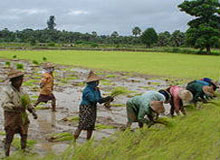When the military coup took place in Burma (now Myanmar) some half a century ago, the first victims were members of the very large Indian community. Burma had traditionally been an integral component of the trade route between India and China. In later years, Burma was part of the British empire. The Indian rupee was the legal tender of Burma for some years after the Independence of the two countries in the late 1940s. The sons of southern Indian business families were sent to Rangoon (now Yangon) to gain experience, Burma was, in short, a second home to many Indians.
Disaster struck in the middle of the last century and worsened after the military coup in 1962. Indian businesses were nationalized, their money and bank accounts were confiscated, and they were exiled from the country with just their shirts on their backs. [This was to happen in Uganda later.]
It has taken half-a-century for those memories to fade. When Indian Prime Minister Manmohan Singh visited Myanmar at the end of May, it was projected as the beginning of a new relationship.
Last Frontier for Reforms
Burma is one of the last large countries to take the reform route. It has two choices. It can either muddle along as India has been doing; the problem of a democracy is that you must take everybody on board. Things move slowly. It takes a new crisis — as is being experienced by India now — to get the ship of government back on the rails. Or you can fly — like China. If you are lucky, you manage; if you are not, the pressure cooker will explode. The liberalization process will get a setback from which it may take years to recover.
There don’t seem to be too many doubts that Myanmar President U. Thein Sein has some reformist aspirations. Over the past few years, he has patched up relations with pro-democracy Nobel Prize winner Aung San Suu Kyi, who leads the opposition. He has held some sort of elections, where Suu Kyi’s party bagged 43 of the 45 seats on offer. (The Myanmar Parliament has more than 600 seats, so a transition to an elected government has a long way to go.)
The Indian Prime Minister is not alone in accepting the democratic credentials of the ruling general. U.S. Secretary of State Hilary Clinton is also a convert. On May 17, after meeting Myanmar foreign minister U. Wunna Maung Lwin in Washington, Clinton told a press conference at the state department’s Treaty Room: “Today we say to America’s businesses: invest in Burma.” U.S. President Barack Obama added. “As an iron fist has unclenched in Burma, we have extended our hand,”. He lifted the trade sanctions that have been in place since 1993. He also nominated Derek Mitchell as ambassador to Myanmar. Mitchell has previously served as the state department’s special representative to that country.
There was some excitement in Yangon. But it was muted. The generals have promised democracy on several occasions. But they have always ended with the people asking for more and brutally repressed uprisings. Why should this time be any different?
Corporate America too didn’t show much visible excitement about investing in Myanmar. When Vietnam was thrown open by President Bill Clinton in 1994, Coke and Pepsi rushed into the country. Bottles of the soft drink were made available — free — on the streets of Ho Chi Minh City in just a few hours. Today, U.S. investment will come, but in more measured fashion.
Stream of Visitors
Besides, the world has changed. In Myanmar, instead of leading the way, the U.S. has been content to be a follower. Visitors to the country in recent times include British Prime Minister David Cameron, U.N secretary-general Ban Ki-moon, Indian Prime Minister Manmohan Singh, Malaysian Prime Minister Mohammad Najib Abdul Razak and Thai PM Nayok Ratthamontri Haeng Ratcha-anachak Thai. Hilary Clinton did stop by last December, but she spent more time with Suu Kyi than with Sien. It’s a measure of Myanmar’s isolation that Clinton is the senior-most U.S. official to visit Myanmar since Secretary of State John Foster Dulles in 1955.
Manmohan Singh’s visit caused a few ripples in Beijing, which has been sending a stream of high-level visitors to Myanmar. The junta rushed a team to China to show where its loyalties lay. Doubts at rest, Chinese foreign ministry spokesman Liu Weimin told the Times of India: “China is happy to see the development of relations between them [India and Myanmar].”
Singh is the first senior Indian leader to visit Myanmar in 25 years. President Sein had visited India in October 2011, partly for a pilgrimage of Buddhist shrines, and this was in a sense a reciprocal trip. But it also signaled that India was not about to give up on Myanmar as a source for its natural resource needs. In fact, if Suu Kyi comes to power some day, India has a distinct edge in its rivalry with China. Today, however, the Suu Kyi camp is irked with India for cozying up to the general.
As an indicator of priorities, Singh was accompanied by a team of senior businessmen and industrialists. Sein couldn’t find their counterparts; there are no senior businessmen in Myanmar. The country has seen almost all its industry nationalized. The Indian team included telecom czar Sunil Bharti Mittal, who has already spread his wings to Africa and Bangladesh, the Essar Group’s Ravi Ruia, B. Muthuraman of the Tatas, and Naveen Jindal of Jindal Steel.
Early Birds
Some Indian firms already have a presence in Myanmar. The Ruias have won the contract for the US$214 million Kaladan Multimodal Transit Transport Project. The Tatas have entered into a distribution agreement with Apex Greatest Industrial Co to sell its commercial vehicles and passenger cars in Myanmar. “Other products may be added to the list later,” says a Tata spokesperson. The Tatas have been assembling heavy trucks in the country for the past two years.
For the Tatas, Myanmar is a stepping stone to south-east Asia. It’s been a long-standing ambition of the group to target these markets. West Bengal proved a non-starter. Everyone remembers the Nano small car project, which was hounded out of the state by current chief minister Mamata Banerjee. But there were other efforts too, such as Haldia Petrochemicals. Bangladesh also didn’t live up to its promise. One of the major Indo-Myanmar projects on the cards is a direct road link to Thailand. The Tatas want to be in the east to tap this lifeline when it comes up.
The 15-strong business team that accompanied Singh all have designs on Myanmar. Some memoranda of understanding (MoUs) were signed; some projects were identified. “Myanmar is a country that offers a huge potential for Indian companies” says Sanjay Kirloskar, chairman and managing director of Kirloskar Brothers, who was part of the team. Jubilant Energy, part of the Jubilant Bhartia Group, won a production sharing contract under the Myanmar Onshore Blocks Bidding Round. Jubilant will tap the synergies with the four blocks it has won in the north-eastern Indian states of Tripura, Manipur and Assam. “This is a significant development for Jubilant,” says Shyam Bhartia, chairman of the company.
Also accompanying the delegation were officials of United Bank of India (UBI) and Exim Bank. “We will open a representative office in Yangon soon,” UBI chairman and managing director Bhaskar Sen had told a seminar on ‘India-Myanmar trade relations’ in Kolkata a few months ago. “The [Indian] government has given its approval.”
Investment apart,trade is one front in which there is ample scope for growth. According to a report by the Confederation of Indian Industries (CII), titled ‘India-Myanmar — Expanding bilateral cooperation’: “India and Myanmar have seen substantial increase in their bilateral trade.” That may be technically correct. But in absolute terms, it was only US$1.35 billion in 2010-11. “This implies that the sky is the limit,” says a CII spokesperson. Myanmar’s trade with China is around US$6.5 billion.
Rivalry for Natural Resources
India and China – among the fastest-growing large economies in the world — have been competing in many places in their quest for natural resources. “The two Asian giants are focusing on Africa as never before,” says Businessweek. Myanmar is the latest arena. It has energy resources both the countries are hungry for and a lot else besides. China is clearly ahead. Since 1988, it has enjoyed a sort of most-favored nation status.
But, of late, there have been some signs of disenchantment. A major dam on the Irrawaddy being constructed by China has been suspended for environmental reasons. The London Guardian reports that many smaller projects are in trouble and several protestors have been killed. Despite all that, China is ahead of India. “But I do not think we have missed the bus,” says Mittal.”Myanmar is just starting to happen.”
“China is involved too deeply in Myanmar,” says M.P. Bezbaruah of the department of economics, Guwahati University, and the author of ‘Indo-Myanmar Cross-Border Trade. “But Myanmar may not be too comfortable depending heavily on one country. We must learn to be engaged in Myanmar as yet another partner. In fact, if India and China learn to deal with each other with more mutual trust, it may be beneficial for all three countries.” Adds Vibhanshu Shekhar, research fellow, Indian Council of World Affairs, Delhi: “The China factor has been unnecessarily blown out of proportion. India should pay attention to what it wants to achieve in the long run and what kind of relationship it wants with Myanmar. India has enormous social, cultural, and political capital in Myanmar. All it needs to do is capitalize on that and build a long-term strategic partnership with the country.”
Will reforms in Myanmar be faster than China, Vietnam or India? “Can’t say,” responds Bezbaruah. Explains Shekhar: “It will take place at the pace the Myanmar generals are comfortable with.” Rajiv Biswas, Asia-Pacific chief economist for IHS Global Insight, feels that Myanmar is set to become Asia’s latest tiger economy. “But only if the pace of reform is sustained.”
In Ratnagiri in Maharashtra is the palace of the last Burmese King Thibaw Min. He was exiled there by the British. In a forgotten corner of Yangon is the tomb of Bahadur Shah Zafar, the last Mughal emperor. He was exiled there by the British. This is another thing the two countries have in common.



